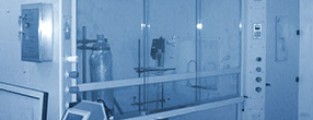Fume Cabinet Performance
The only statutory control relevant to the use of fume cabinets is the Control of Substances Hazardous to Health Regulations. While regulation nine stipulates that all systems should be maintained, examined and tested at a frequency laid down in Schedule 3 no reference if given to what constitutes acceptable performance other than that employees are protected.
Two HSE documents directly refer to the performance of fume cabinets:
CoSHH Control Guidance Sheet 201 Fume Cabinets.
States that air flow at the opening of the cupboard should be at least 0.5m/s for vapour and 1.0m/s dust.
HSG 258 controlling Airborne Contaminants at Work.
States that fume cabinets should be tested according to appropriate BS and EN standards. It also states that the required capture velocity for contaminants generated in still air with little or no energy should be in the range of 0.25-0.5m/s and for those generated in fairly still air with low energy to be in the range 0.5-1.0m/s.
As can be seen there is no statutory duty controlling the performance of a fume cabinet though there is none compulsory guidance that states that the face velocity should be at least 0.5m/s though it doesn’t mention whether or not this is an average figure and that it should have a variation no greater that 20% from the average.
BS EN 14175 does not comment on the required face velocities however is state that for type testing and commissioning when the cabinet is emply the face velocity should not vary by more than 10% from the average.
The older BS EN 7258 does not directly refer to minimum face velocity figure however Part 1, Note 3 says that in practice face velocities below 0.3m/s are unlikely to be effective and that in some case face velocities of 0.5m/s or more may be necessary. The United States have in many ways pioneered Occupational Hygiene and the use of local exhaust ventilation and it is to them that we have to look in order to trace the source of many commonly used face velocity figures. Here several governmental and industry organizations have adopted fume hood safety standards. The intent of these standards is to designate face velocities that are high enough to contain fumes but not so high as to cause air turbulence between a hood’s face and a worker. Below is a list of some standards organizations and the face velocities they require:
OSHA (Federal Occupational Safety and Health Administration)
“hood face velocity should be typically 60-100 lfm…”
Cal/OSHA (California Occupational Safety and Health Administration)
“requires 100 linear feet per minute with a minimum 70fpm at any one point, except for hoods with carcinogens, which require 150fpm and a minimum of 125fpm.”
National Research Council
“recommends face velocities between 80 and 100fpm. 120fpm is recommended for substances with very high toxicity or where outside influences adversely influence hood performance. Face velocities approaching or exceeding 150fpm should not be used.”
ANSI/AIHA (American National Standards Institute / American Industrial Hygiene association)
“Each hood shall maintain an average face velocity of 80-120 fpm with no face velocity measurement more than plus or minus 20% of the average.”
S.E.F.A (Scientific Equipment & Furniture Association)
“A fume hood face velocity of 100 fpm is considered acceptable in standard practice. In certain situations face velocity of up to 125 fpm or as low as 75 fpm may be acceptable to meet required capture velocity of the fume hood.”
N.I.H. (National Institutes of Health)
“Face velocity measurements shall meet an air velocity profile of 100 fpm plus or minus 10 fpm with the sash fully open.”
NIOSH (National Institute of Occupational Safety and Health)
“Recommends face velocities of 100 to 150 fpm”
ACGIH (American Congress of Governmental and Industrial Hygienists)
“Recommends 80 – 100 fpm face velocity with a full open sash depending on quality of supply air distribution and uniformity of face velocity.”
Summary
The largest source of advice of fume cabinet face velocity guidance is undoubtedly the USA. Generally when you convert their measurements in to meters per second there is a consensus that face velocities should generally be in the range 0.4 – 0.6 m/s with a deviation of no more that 20% from the average at any one point. However when handing more hazardous materials such as carcinogens then face velocities greater than this may be appropriate up to 0.8m/s.
Interpretation of the Guidance Available
The optimal average face velocity is often quoted as 0.5 m/s at a 500 mm sash opening. And this has been adopted by many organizations and institutions. This does meet the HSE guidance as a minimum standard however it does not reflect the wider international recommendations. It may be wiser to consider the following average requirements:
0.5 m/s at a working opening for all work not involving very toxic or toxic substances. Ideally there should not be a deviation of no more that 20% from the average at any one point. 0.6 – 0.8 m/s at a working opening for all work involving very toxic, toxic, carcinogenic or radioactive substances. Ideally there should not be a deviation of no more that 20% from the average at any one point.
Note the working opening should normally be no more than 500 mm and the face velocity should be no more than 1.0 m/s at the working opening, otherwise loss of containment is likely to result due to turbulence.
The “maximum safe opening” marked on fume cupboards indicates the aperture at which a face velocity of 0.5 m/s is achieved. It does not mean that the sash should be kept at this opening; it should normally be kept much lower than the maximum. Users should be reminded where bad practice is seen.
Use of Face Velocity Figures
In reality the measurement of average face velocity with a set measured range tolerance as mentioned in the BS EN standards has its place in type testing and the commissioning of new systems. They may also be of use to the LEV inspector carrying out thorough examination and test but I don’t however see their place during routine in-house testing. The purpose of routine testing is to make simple performance checks that might identify a drop in performance that may occur between the statutory inspections. There is no real requirement to commission systems on a monthly basis. The measurement range tolerance as stated in BS EN 14175 is an ideal that should be achievable for new fume cabinets however it will often be simply unachievable for older cabinets.
Recommendations
- Consider the formal commissioning of all fume cabinets. This would be best done using a containment test. Sulphur Hexafluoride is released into a cabinets and leakage is monitored by an infra red gas analyser. This would allow cabinets to be rated on their effectiveness.
- It may be necessary to rate each fume cabinet for the types of hazardous material that can be used in them. With only the better performing systems being acceptable for the control of carcinogens etc.
- This commissioning test would establish face velocity measurements that could be utilised on subsequent statutory thorough examination and tests.
- The testing criteria set for the fume cabinets should acknowledge that failing to meet a BS EN standard does not necessarily been that exposure will be occurring.
- Thorough examination and test should be carried out by a competent P601 qualified LEV tester.
Leave a Reply
Recent Posts
Fume Cabinet Performance
30/04/2012 • The only statutory control relevant to the use of fume cabinets is the Control of Substances Hazardous to Health Regulations.... more
Ice Safety
30/04/2012 • Here are some general guidelines on the strength of ice at different thicknesses. Just after freeze up, ice in the middle... more
Carbon Monoxide Poisoning
09/09/2011 • Paul Ramsden, Integral HSE’s principle consultant while be presenting a poster on the causes of carbon monoxide poisoning in Antactic... more





